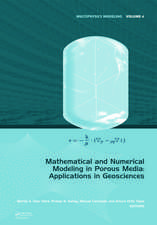Mathematical Theory of Elastic Structures
Autor Kang Feng, Zhong-Ci Shien Limba Engleză Paperback – 3 oct 2013
Preț: 394.51 lei
Nou
Puncte Express: 592
Preț estimativ în valută:
75.49€ • 80.72$ • 62.94£
75.49€ • 80.72$ • 62.94£
Carte tipărită la comandă
Livrare economică 17 aprilie-01 mai
Preluare comenzi: 021 569.72.76
Specificații
ISBN-13: 9783662032886
ISBN-10: 3662032880
Pagini: 408
Ilustrații: XI, 395 p. 18 illus.
Dimensiuni: 155 x 235 x 21 mm
Greutate: 0.57 kg
Ediția:Softcover reprint of the original 1st ed. 1996
Editura: Springer Berlin, Heidelberg
Colecția Springer
Locul publicării:Berlin, Heidelberg, Germany
ISBN-10: 3662032880
Pagini: 408
Ilustrații: XI, 395 p. 18 illus.
Dimensiuni: 155 x 235 x 21 mm
Greutate: 0.57 kg
Ediția:Softcover reprint of the original 1st ed. 1996
Editura: Springer Berlin, Heidelberg
Colecția Springer
Locul publicării:Berlin, Heidelberg, Germany
Public țintă
ResearchCuprins
1 Simple Modes of Elastic Deformation.- 2 Static Elasticity.- 3 Typical Problems of Elastic Equilibrium.- 4 Composite Elastic Structures.- 5 Finite Element Methods.- References.
Textul de pe ultima copertă
The book covers three main topics: the classical theory of linear elasticity, the mathematical theory of composite elastic structures, as an application of the theory of elliptic equations on composite manifolds developed by the first author, and the finite element method for solving elastic structural problems.
The authors treat these topics within the framework of a unified theory. The book carries on a theoretical discussion on the mathematical basis of the principle of minimum potential theory. The emphasis is on the accuracy and completeness of the mathematical formulation of elastic structural problems.
The book will be useful to applied mathematicians, engineers and graduate students. It may also serve as a course in elasticity for undergraduate students in applied sciences.
The authors treat these topics within the framework of a unified theory. The book carries on a theoretical discussion on the mathematical basis of the principle of minimum potential theory. The emphasis is on the accuracy and completeness of the mathematical formulation of elastic structural problems.
The book will be useful to applied mathematicians, engineers and graduate students. It may also serve as a course in elasticity for undergraduate students in applied sciences.











